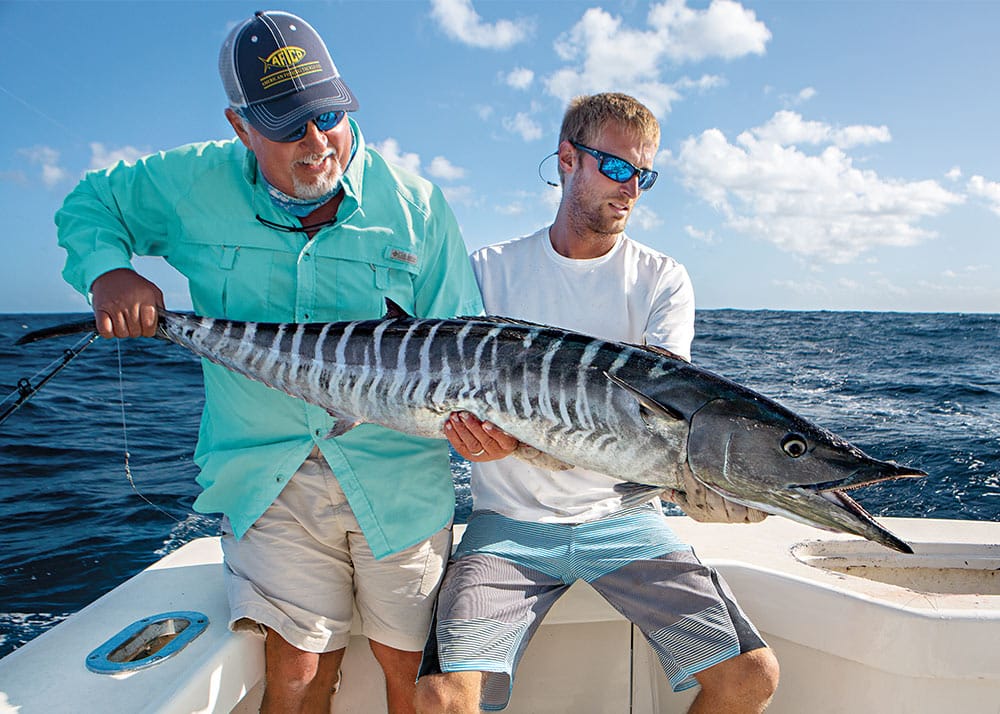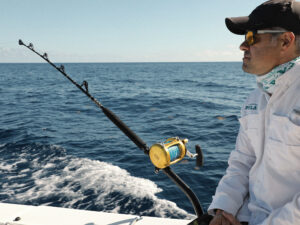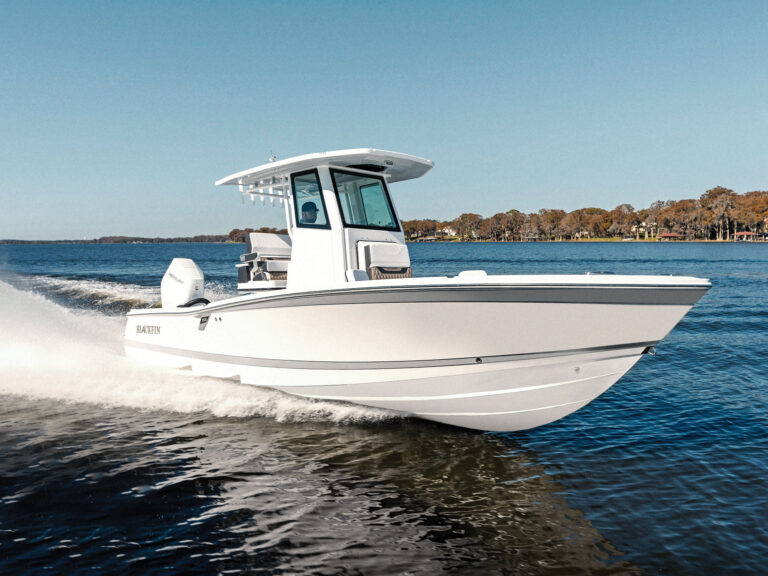
We deployed our spread at dawn, just before reaching the first drop in the continental shelf, and within minutes the shotgun bait got mauled. Capt. Mark “Microwave” Chambers hooked the fish from the bridge of Reel Country and passed the rod to the cockpit, where the crew watched line evaporate from the reel.
Chambers maintained course and speed, and one of the flat lines got hit a moment later. We had ourselves a doubleheader. Thanks to Luke Snedaker and Zach Davenport’s fancy footwork, a pair of wahoo, a 40- and a 30-pounder, hit the ice as the sun rose above the horizon.

2. Two similar lure-bait combos — with 16- to 36-ounce cigar sinkers 30 feet ahead — set 200 and 250 feet back, off port and starboard flat lines.
3. No. 4 Drone spoon 100 feet back, off a bent-butt rod on a transom corner with a No. 12, 16 or 24 planer 60 feet up the leader, bridled with clips for easy removal when reeling in a fish.
4. Iland lure-ballyhoo combo 150 feet back and 50 feet down, off a downrigger. FYI: Recommended speed is 6 to 9 knots. To troll at the higher end of the speed range, substitute the Drone spoon behind the planer for an Ilander-bait combo. Rig trolling sinkers with 4 feet of No. 9 wire to prevent cutoffs from wahoo attacks. Steve Sanford
Carolina Lineup
Charter boats from the Outer Banks point to May, when the temperature of the water reaches the mid-70s, as the month when wahoo begin congregating in the region, but most consider late summer and fall, when water temps hover around 80 degrees, as the peak of the wahoo run.
Anglers from Oregon Inlet focus their search on well-known spots like the Tuna Hole, the Point and Whale Hole. Boats out of Hatteras patrol favorites like the Rockpile, the Beach, Big Rock, 200 Rocks, and various deep wrecks where fish suspend around the bottom structure.

Farther south, off Beaufort Inlet, crews key on color changes and drop-offs, or rises on the bottom along the edge of the continental shelf, paying particular attention to where the current pushes over structure creating upwellings that aggregate small bonito and other prey.
Purple-and-black, red-and-black, pink-and-blue, or yellow-and-green Joe Shute or Iland lures over large ballyhoo rigged with 9/0 or 10/0 hook tandems are a mainstay in trolling spreads. In North Carolina, so is a Drone spoon behind a planer. An identical setup is often fished off the opposite side, farther back, and some crews opt for a downrigger instead to troll another Iland lure-ballyhoo combo deeper than a planer allows. A six-line spread is effective and manageable, even aboard small center- consoles with a reduced crew.

2. Drop another live bait 150 feet back, off a second flat line on the opposite transom corner.
3. Set a third livey 100 feet back and 30 feet down, off a downrigger (on the same side as the longest flat line).
4. Troll a fourth live bait 60 feet back and 50 feet down off another downrigger. FYI: Recommended speed is 2 to 4 knots (based on bait size and species). Use stinger hooks for more hookups. Steve Sanford
Bermuda Shorts
Bermuda is renowned for its terrific wahoo fishery, which peaks in late winter and spring, slows down in the summer, and picks up again in autumn when larger fish show up.
Challenger and Argus, renowned offshore banks southwest of the island, are perennial producers, but action is often encountered much closer to shore, along the first drop, where vast bait schools gather, attracting wahoo. And the fish are widespread along Bermuda’s south shore and the southeast corner during the fall, when it pays to troll close to the edge, in 180 to 330 feet of water.

Many Bermuda crews keep their trolling spreads short, fishing baits closer to the transom than in other places. Some opt for trolling Iland lure-ballyhoo combinations here too, while others prefer Jr. Ilander lures and chin-weighted flying fish instead of ballyhoo. Yet many locals bet on live bait, especially in the fall when many wahoo exceed 40 pounds, and start their day by catching a supply of robins (redtail scad, aka speedos in Florida), frigate mackerel or small little tunny (also called bonito or albies) to troll on a four-line spread, with one or two downriggers to cover the water column down to 50 feet.

2. Same lure and bait 200 feet back, off opposite gunwale.
3. Two more lures and baits 150 and 100 feet back, both behind No. 12, 16 or 24 planers on bent-butt rods off transom corners.
4. Smoker lure 350 feet back, off tower or hardtop. FYI: Best speed is 6 to 9 knots. Fish Joe Shute Cruisers or Flat Liners on gunwale lines and add cigar sinkers, if choppy. Steve Sanford
Bahamas Banking
In the Bahamas, San Salvador and Cat Island host a spectacular wahoo bite during the fall and winter months. A number of world records have been recorded in those waters. But excellent action also occurs off Grand Bahama’s West End, along the western edges of the Grand and Little Bahama banks, and the Navy buoys in the Tongue of the Ocean, in front of Andros.
A spread of five Ilanders with rigged ballyhoo, two off planers 20 to 30 feet down, works wonders on Bahamian wahoo.
A neat trick enhances the effectiveness of the offerings in the spread: Rather than troll straight along a drop-off or ledge, follow a zigzag pattern, alternating 20-degree turns to both sides. This maneuver allows the baits on the inside of every turn to slow down a bit and also sink a little before they again speed up and surge toward the surface as the boat straightens.

2. Second lure 250 feet back, off the opposite gunwale.
3. Third lure 200 feet back, off a transom rod (closest to the longest line).
4. Fourth lure 50 feet shorter, off the transom.
5. Fifth lure on shotgun line down the middle, 350 feet back, off the tower or hardtop. FYI: Best speed is 12 to 15 knots. Use 10-ounce Joe Shute Cruisers, 8-ounce Flat Liners or Iland Crusaders to prevent skipping and line tangles. Smaller boats and bumpy seas may require sinkers (16 to 48 ounces) up the leader. Steve Sanford
NorthEast Florida Ledge-islation
In northeast Florida, wahoo season gets going in November, and the best action occurs from February through April. Here wahoo addicts center their efforts around the 28-fathom curve, where the Ledge, a 30-foot drop from 170 to 200 feet, holds enough fish to warrant the 55- to 60-mile run offshore from Fernandina Beach, Jacksonville and St. Augustine.
Although bottom structure is important, water temperature is also a key factor. Come winter, wahoo search for forage and milder water. Since the temperature of the Gulf Stream remains rather constant, finding an eddy drawing the current’s warmer, nutrient-rich water close to the Ledge is bound to pay dividends, so the more successful anglers review sea-surface charts and satellite images of the Gulf Stream to identify temperature breaks and eddies. While 78-degree water is ideal, locating a temperature break from 68 to 72 degrees in the winter is a major cue.
Speed-trolling in a zigzag pattern with five bullet-shaped lures without ballyhoo, which wash out quickly at high speeds, is an effective way to search for wahoo. When you catch a fish, make more passes through the same water from different headings. If you find willing ’hoos, switch to ballyhoo with Iland lures and slow down.

2. X-Rap Magnum 30 set 20 feet closer.
3. Another Magnum 30 placed 80 feet behind the transom.
4. Magnum 40 run 60 feet back. 5. If possible, add Yo-Zuri Sashimi Bonitas or Mag Bay Desperados 175 and 150 feet back. FYI: Recommended speed is 8 to 12 knots. Magnums troll slower but dive deeper than Bonitas and Desperados. Steve Sanford
Keys Plugging
In the Florida Keys, wahoo gather over wrecks and along the slope of offshore mounts and reefs. Off Key West, veteran captains fish hot spots like the Sub, Wood’s Wall, Coalbin Rock, Rebecca Shoals, Cosgrove Shoals, Tail End Buoy, and the end of The Bar, a long reef off Boca Grande Key, where the bottom plummets from 30 feet to considerable depths over a short span.
Wahoo numbers in the Keys begin to build in autumn and peak in the winter, when some anglers troll strictly artificials at high speeds to cover more water and trigger strikes from fish competing with others in the same area.
Ballyhoo with Iland lures in front and one or two smokers like the Sea Searcher or Iland Express farther back are ideal for the task. Yet heavy-duty diving plugs, like the Rapala X-Rap Magnum, Yo-Zuri Sashimi Bonita or Mag Bay Desperado, trolled in a V formation and staggered at various depths cover the water column better without downriggers or planers.

2. Lure and bait 300 feet back, off opposite rigger.
3. Lure and bait behind 24- to 36-ounce cigar sinker, 250 feet back, off closest gunwale to long rigger.
4. Lure and bait behind 24- to 36-ounce cigar sinker, 200 feet back, off opposite gunwale.
5. Yo-Zuri Sashimi Bonitas 150 and 100 feet back. 6. Smoker lure 400 feet back, off the tower or hardtop. FYI: Best speed is 8 to 12 knots. Steve Sanford
Gulf Coast Medley
From Florida’s Panhandle to the South Texas coast, anglers find wahoo from November through February in wrecks and oil platforms in 250 to 300 feet (35 to 40 miles out), on underwater mounds and floating oil rigs farther offshore in late winter, and under floating grass in the summer, when weed lines gather in the Gulf of Mexico, along the edge of the Loop Current.
Boats out of Pensacola and Orange Beach troll the 100-fathom curve, where the most drastic bottom features are located. Other famous wahoo spots in the eastern Gulf include the Oriskany, the Steps and Alabama Alps. And in Texas, notorious wahoo grounds, like East and West Flower Gardens and Stetson Bank, lie 100 to 125 miles southeast of Galveston.
Some crews in the Gulf of Mexico opt for high-speed trolling with artificials on calm days, while others pull a seven-line spread comprising bullet-shaped lures with rigged ballyhoo, an Iland Express or Sea Searcher smoker on a long shotgun, and a pair of swimming plugs at a medium pace.

Top Wahoo Spread Candidates











